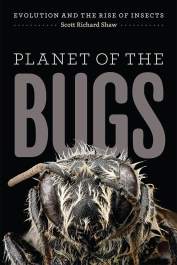Planet of the Bugs: Evolution and the Rise of Insects
 Scott Richard Shaw
Scott Richard Shaw
The University of Chicago Press, £12.00
Understanding how insects became the largest animal group on Earth is not usually covered in school. In this book, Scott Shaw takes us on an immense journey from the Cambrian explosion all the way to the modern day to explain how the 'rise of insects' occurred. He explains how insect groups arose, evolved, became extinct and survived cataclysmic events such as the end-Permian mass extinction. He also suggests their effect on other groups of organisms and the development of insect strategies.
The title of chapter one, The Buggy Planet, gives an indication of the relaxed writing style that Shaw uses, but he does not scrimp on scientific information.
Instead, he makes evolution accessible to everyone, just in a different light – from an insect perspective. If you are not familiar with insect groups and their scientific names, it can get a little intense, although the common names are used alongside them to help the reader. There are also extra notes at the back, along with a reading list for those who want to know more.
Shaw is professor of entomology at the University of Wyoming and he packs the book full of interesting information and facts, linking past events in the evolution of insects to those we know of today. The journey ends with a brief overview of the effect humans are currently having on insects, and how life on other planets could possibly be dominated by insect forms – the 'Buggy Universe' hypothesis.
For anyone interested in insects, this is a fascinating and informative read from someone passionate about our six-legged friends.
Janet Preece CBiol MRSB


